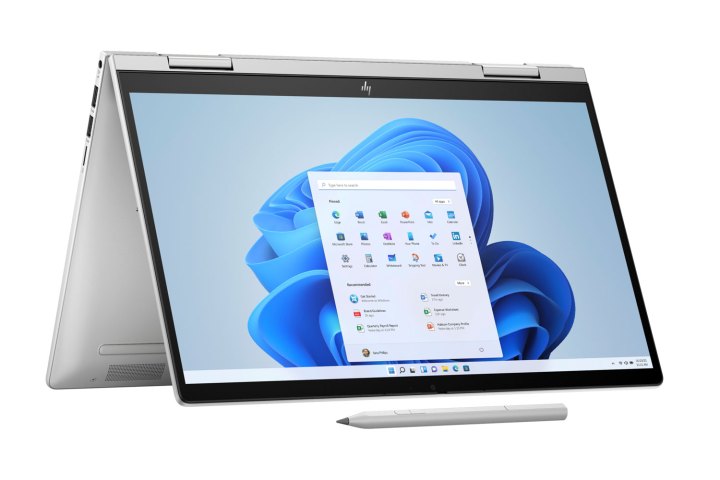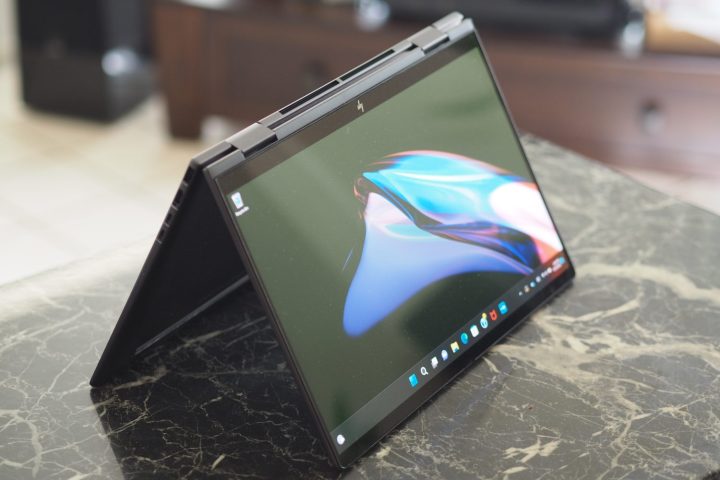
HP has been a go-to choice for laptops and desktop PCs for several decades now. Pre-loaded with the Windows operating system, two of the company’s most popular lineups include its Envy and Pavilion machines. These are feature-rich computers, and they’re pretty budget-friendly too, but which of the two HP families reigns supreme? Let’s compare them to find out.
HP Envy

The latest generation HP Envy laptops can be divided in two main design categories: traditional clamshell laptops (HP Envy) and 2-in-1 laptops (HP Envy x360). Where the HP Envy range has previously covered every major laptop size, the latest generation of clamshell designs is limited to just 16- and 17-inch models. The Envy X360 range offers 15- and 14-inch models.
The features each clamshell laptop offers will vary depending on the size you choose. But overall, you can expect displays with three-sided narrow bezels, touchscreen options, IPS displays, fingerprint readers, backlit keyboards (some with numeric keypads), HD cameras, dual-array microphones, webcam shutters, microphone mute buttons, and port selections that include Thunderbolt 4, microSD card readers, and USB-C and USB-A.
When it comes to weight, the clamshell portion of the Envy line does skew a bit toward the heavy side, with the biggest 17-inch models weighing around 5.5 pounds, and the smaller 16-inch models tipping the scales at about 5 pounds. That additional weight comes from having access to higher-end processors and GPUs, with options ranging from entry-level Core i5 Intel 13th-generation CPUs with Iris Xe graphics to upper-midrange CPUs like the 13700H and Nvidia RTX 3000 and 4000 entry-level graphics chips.
The latest Envy x360 models come with a 360-degree hinge that allows the laptop to be folded into different display modes, such as tablet, stand, or tent. Like their clamshell counterparts, the Envy x360 line of laptops has features that vary among its products, but you can generally expect to see the following among them: narrow bezel displays of varying thickness, fingerprint readers, backlit keyboards, keyboards with numeric keypads, touch-enabled displays, HD webcams, privacy camera shutters, microphone mute keys, and dual array microphones. Port selections include USB-C and USB-A ports, HDMI 2.1, Thunderbolt 4, and microSD card readers.
You’ll also see, depending on the model, built-in privacy screens and a variety of sensors: accelerometers, gyroscopes, eCompass, and IR thermal sensors.
In terms of weight, the Envy x360 line is a bit on the lighter side compared to the Envy clamshells. The lightest model weighs around 3.4 pounds, though the larger models are a little heavier. You’ll find more efficient CPUs and graphics in this line too, with models like the Intel Core i5 1355U. There are some models with the option of an AMD CPU instead. These tend to offer comparable performance, but better efficiency, so they can improve battery life in some cases.
Both the Envy x360 and Envy clamshells offer FHD and IPS displays, and you can also find options for WUXGA, UHD, and even 4K UHD displays.
HP Pavilion

HP’s Pavilion line offers laptops that fall into four main design categories: clamshells (Pavilion), 2-in-1s (Pavilion x360), ultra-lightweight (Pavilion Aero), and gaming laptops (Pavilion Gaming). Although HP used to have a dedicated gaming design, it’s not as prominent today. For gaming, you’re better off focusing on HP’s Omen or Victus lines.
Pavilion
The standard Pavilion clamshell laptops come in three size options: 14, 15, and 16 inches. In terms of processors, you’ll find both Intel 13th-generation and AMD Ryzen 7000 options. You’ll also find FHD 2.8K displays, IPS displays, up to 1TB of solid-state drive (SSD) storage, backlit keyboards, keyboard with numeric keypads (on the larger models), HD webcams, dual array mics, dual speakers, microSD card readers, and a selection of ports that include USB-C, USB-A, and HDMI 2.1. None of the Pavilion clamshells have Thunderbolt ports. These Pavilions also have displays with three-sided narrow bezels. Fingerprint readers are only available on a few models, unlike the Envy line.
The Pavilion clamshells aren’t the lightest laptops the Pavilion line has to offer, but they’re not heavyweights, either. You can expect a weight range of 3 and 4 pounds.
Pavilion x360
Like the Envy x360, you can expect these 2-in-1s from the HP Pavilion line to feature a 360-degree hinge, which allows for four display modes: laptop, tablet, reverse, and tent. The latest generation is only available in the 14-inch size at the time of writing, with older Intel 12th-generation models still available at 14 and 15-inches.
With these 2-in-1s, you’ll see three-sided narrow bezel displays, displays with HD or FHD resolutions, IPS displays, touchscreens, HD webcams, dual array mics, and selections of ports that include microSD card readers, USB-C and USB-A ports, and HDMI 2.1 ports. Thunderbolt ports are also missing from the Pavilion x360 laptops, but they do have three kinds of sensors: an accelerometer, a gyroscope, and eCompass.
Some of the x360 configurations have backlit keyboards, and some do not. Others have backlit keyboards and numerical keypads. Like the Pavilion clamshells, the Pavilion x360s also don’t have many models with fingerprint readers. These laptops are also midrange when it comes to their weight, which is around 3.5 pounds.
Pavilion Aero
HP’s Pavilion Aero is designed to be incredibly lightweight. It’s only 13 inches and weighs less than 2.2 pounds, which makes it the lightest laptop out of both the Pavilion and Envy laptop lines. The Aero sports a magnesium chassis and a 16:10 four-sided narrow bezel display. There are slight variations among the Aero models, but you can expect to see the following features among them: AMD Ryzen 5 and 7 processors, displays with WUXGA or WQXGA resolutions, IPS displays, up to 1TB of SSD storage, fingerprint readers, backlit and non-backlit keyboards, HD webcams, dual-array mics, dual speakers, and selections of ports that include USB-C, USB-A, and HDMI 2.1 ports.
When should you buy an Envy?

If you need a dedicated work laptop, get an Envy. The Envy laptop line has lightweight options if you need a portable machine for working on the go. Plus, it has the privacy features you need to keep your work and your information safe, including fingerprint readers, webcam shutters, microphone mute buttons, and even built-in privacy screens. Envy laptops also have a wider selection of productivity-friendly ports like Thunderbolt 4 and HDMI 2.1.
Envy laptops have even made it into two of our “best laptops” guides and have done so for their potential for productivity. The best business laptops guide features a prominent HP Envy design that’s well worth considering.
You’ll find some dedicated GPUs for gaming with HP Envy laptops too, so if you want to do a little playing in your downtime, they’re the better choice.
When should you buy a Pavilion?

You should opt for a Pavilion laptop if you want a general-purpose laptop, an entertainment laptop, or a budget laptop.
Pavilion laptops are marketed and designed to either emphasize entertainment or work. But generally speaking, productivity is kind of treated as an afterthought when it comes to Pavilion laptops, and it’s pretty obvious when you look at the included features and what they lack. There are a wide variety of display resolution options, narrow-bezel displays, and dual speakers. Pavilions, however, don’t have very many models with fingerprint readers, an important security feature that workstation laptops tend to have. And they also don’t have Thunderbolt ports, unlike their more work-friendly Envy counterparts.
You should also consider getting a Pavilion laptop if you really need a lightweight machine because the Pavilion line has a collection dedicated to that as well: the Pavilion Aero. You can still get many of the same features found on the other Pavilion laptops and do so without having to lug around a heavy machine. Aero laptops weigh less than 2.2 pounds.
How much can you expect to spend?
Barring any sale prices or discounts, you can expect to spend anywhere from $740 to $1,500 on an Envy laptop. Pavilion laptops tend to be priced between $600 and $1,200.
The Pavilion line has more budget-friendly options overall and has lower prices than the Envy laptop line.
They each have their strengths
Which is better? It depends on your needs and budget. The Envy line is best for those who need a professional-grade machine, but you should prepare yourself and your wallet to pay pro-level prices. Laptops like the Envy don’t come cheap because they’re outfitted with enhanced security, privacy features, and productivity tools to help optimize your workday.
If you just need a general-purpose laptop for work and play, or you just want a dedicated laptop for recreation, get a Pavilion. They’re cheaper and lighter, but they’ll still enhance your movie-watching or gaming experience, so you can relax properly and in style after a long day.


